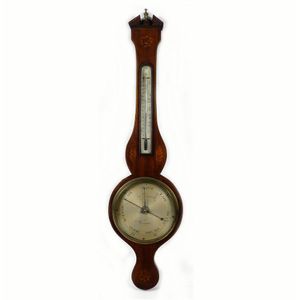Mahogany Banjo Barometer with Shell Inlays
A mid-19th century banjo barometer, break arch pediment, mahogany cased with satinwood shell inlays, the trunk with alcohol thermometer, silvered dial signed Donegan Warranted, height 99 cm.
You must be a subscriber, and be logged in to view price and dealer details.
Subscribe Now to view actual auction price for this item
When you subscribe, you have the option of setting the currency in which to display prices to $Au, $US, $NZ or Stg.
This item has been sold, and the description, image and price are for reference purposes only.
- Mahogany - Mahogany is a dense, close grained red-coloured timber from the West Indies and Central America. It was first imported into Europe in the the early 18th century and its use continued through the 19th century. It was popular for furniture making because of its strength, the wide boards available, the distinctive grain on some boards, termed flame mahogany and the rich warm colour of the timber when it was polished.. The "flame" was produced where a limb grew out from the trunk of the tree, and this timber was usually sliced into veneers for feature panels on doors, backs and cornices.
Some terms used to describe mahogany relate to the country from which it originally came, such as "Cuban" mahogany, "Honduras" mahogany etc. However unless the wood has been tested the names assigned are more a selling feature, rather than a true indication of the timber's origin. - Satinwood - Satinwood is a dense pale gold coloured timber that was imported into Britain in the second half of the 18th century, and early 19th centuries from the East Indies and the West Indies. The name derives from the satin-like surface sheen when the timber is polished.
It was used in the solid, as a veneer and in inlays. As well as furniture, satinwood was used for making musical instruments, barometers, boxes and clocks.
It will usually be found on only the very best quality objects, presumably because of of its cost at the time.
This item has been included into following indexes:
-
barometers, type
- banjo 135
- barometers with thermometer 122
Visually similar items

Crystal boxes, Egyptian painting, five laceworks & box with Chinese figures
Sold by
in
for
You can display prices in $Au, $US, $NZ or Stg.

Iron pyrites snuff bottle with puppy playing
Sold by
in
for
You can display prices in $Au, $US, $NZ or Stg.

Victorian mahogany chiffonier, with 1 drawer and 2 doors, 105 cm wide, 40 cm deep, 145 cm high
Sold by
in
for
You can display prices in $Au, $US, $NZ or Stg.

Sold by
in
for
You can display prices in $Au, $US, $NZ or Stg.
